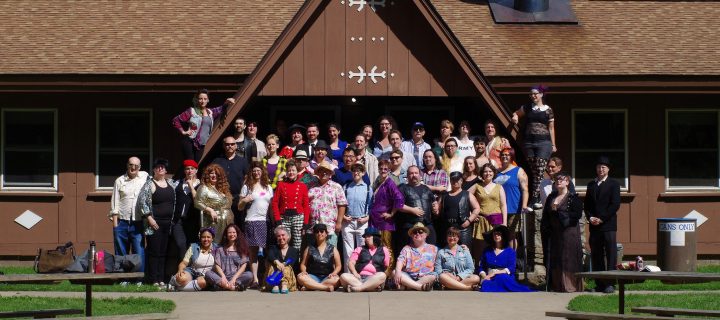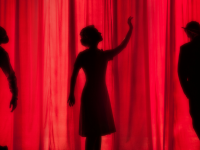On August 7-12, 2017 in Whitewater State Park, Minnesota, USA, 50 larpers and volunteers from five different countries took part in the sixth run of Just a Little Lovin’ (JaLL, 2011). This meant that Tor Kjetil Edland and Hanne Grasmo’s esteemed larp about friendship, desire, and fear of death at the dawn of the HIV/AIDS epidemic, finally found its way to the country of its diegesis: The United States. The run was the culmination of over two years of organizing and many hours of volunteer labor by a diverse team of Nordic and American larpers. It does not even count as hyperbole to say the larp exceeded all of our expectations: it absolutely did. The combination of ground crew, organizers, and excellent players allowed us to create a logistically tight yet deeply human collective experience. Below is an attempt to document one of the already most heavily discussed Nordic larps, albeit in a different fashion: from an organizer perspective, specifically that of the US team.
A game. JaLL is a game, but seems hardly one at all. Does it even remotely belong in the same category as table tennis, Pac-Man (1980), and Dungeons & Dragons (1974)? Indeed, when talking about the larp on an LGBTQ radio show in Minneapolis, we skirted around the term “game” and used the word “experience.” In the US, HIV/AIDS is certainly not considered a topic about which one could create a game, titles such as That Dragon, Cancer (2016) notwithstanding. In addition, the epidemic itself has not really been properly processed in the American public consciousness. Larry Kramer (1983) screamed “plague” to save tens of thousands of lives in the mid-1980s, but even his early pleas to the gay community now seem distant and historical. Yet as HIV activist Andrew Schuster noted at our JaLL post-game workshop, HIV/AIDS still poses an ongoing threat to many communities, and AIDS awareness could not be more pertinent to the coming generations, despite advances in medical treatments and cures. We were larpers, but somehow we were also involved with a form of activism. Or maybe we were just having a US-based conversation that, characteristically, few of us actually have had among themselves.
Site
Perhaps we should start from the beginning. In July 2015, a handful of North American larpers, myself included (Torner 2015), took part in the second Danish run of JaLL. We found the larp so transformative that we vowed to bring it to the USA in the coming 1-2 years. Many locations were thrown around: Saratoga Springs in upstate New York (where the game is actually set), Austin, San Francisco, New Jersey. But the site bid that won was submitted by Jon Cole, a seasoned freeform organizer from the Twin Cities of Minneapolis and St. Paul representing the group Larp House. Jon had assembled a solid ground team, and had found the perfect modern group site at Whitewater, far from civilization and surrounded by natural beauty. Alexander Sandrén, a Swedish player who has been at many runs of the game, remarked that the site was, by far, the closest to what he eined the fictional Saratoga Group Center looked like. I silently noted this as a major victory. Jon’s bid for Whitewater was detailed, precise to a fault, and above all affordable; the US run had to be non-profit, and an inexpensive site with a good group of committed volunteers would alleviate financial and personnel pressures. We decided that, yes, JaLL USA 2017 would be in Minnesota. And so, the planning began in late 2015.
Securing the site itself was, of course, already a problem. A beautiful campsite such as this one was in high demand and heavily booked. One had to call the Whitewater park office at precisely 8 am on particular mornings to book the site for exactly one year later. Several frustrated attempts at reserving our slot led to us finally landing our fifth choice of dates: the week before GenCon. August in Minnesota would mean heat and mosquitos (from which we were fortunately spared in the actual run). Yet we were relieved to at least have the site secured. We blithely posted the Save-The-Date announcement in August 2016 for the following year on social media in celebration.

A leather harness hanging on a bench in Whitewater State Park. Photo by l.p. lade.
Controversy
Then the Internet hit us like a ton of bricks. Or a train. Or a train made of bricks. Given the emboldening of far-right hate groups in 2016, one would think our main critics would have been anti-gay evangelical Christians and neo-Nazis. This wasn’t the case at all: it was, in fact, the progressive left that went into a social media frenzy over the game. Individuals directly affected by the AIDS crisis were ringing our phones in outrage against the ostensible insensitivity of running such a larp. We were called out as being unethical and patrolled for any language suggesting that we might make light of the topic. We were told that the Norwegians, even gay Norwegians, had no right to this shared history, and that this was a “gay larp for straight people,” implying a kind of shameful blackface-level mimicry of a certain vulnerable community at work. The reaction came through closed circles, without even major press coverage of any kind.
Even this private, contained negative backlash left many of us emotionally drained. We had answers for these American social media challenges, many of which had already been raised in the 2011 debate about JaLL in the Swedish newspaper Expressen (Gerge 2012). After all, the larp takes its subject matter seriously, has queer creators, and has, in fact, given queer players their own larp to cherish and in which to feel at home. Nevertheless, much of August 2016 was spent in social media damage control and creating a massive FAQ[1]https://jall.us/faq/ (Accessed January 2018) explaining every facet of the larp to potential participants, as well as its detractors. We also withdrew plans to crowdfund the game and locked down major public releases of information about it, tapping JaLL allies such as Nicole Winchester and Morgan Nuncio to run interference on any discussions of the game that might come up so as to shield the organizers from further flak. Needless to say, organizing a game about which we had been proud suddenly became a curiously furtive endeavor. None of us wanted to be caught as the “leader” of the project, out of fear that we would be left holding the bag full of hate mail and death threats if a Vice or Geek and Sundry article was written about us and a social media storm erupted.
Adaptation
Meanwhile, the larp itself had to undergo its own transformation for the North American context. JaLL may have some of the best storytelling mechanics and complex characters seen in a larp (Waern 2012), but it was also a game that traditionally had white European players portray an almost homogeneously white American group of characters, with the exception of four Puerto Ricans. As admitted by Tor Kjetil and Hanne, this simply did not represent the racial and ethnic diversity of early 1980s New York City. Compounding this fact were developments in language around trans* individuals since the early 1980s: in the historical setting, trans* women and men would call themselves “gay” because there wasn’t yet a better term, and pronoun shifts and non-binary designations were many years to come. How would we balance avoiding the erasure of the non-white experience of the period, letting players of color to calibrate their level of comfort with respect to playing on racism, playing on and celebrating ethnic nuance, and not appropriating or unintentionally mocking any given gender expression, race, ethnicity, and culture? None of us assumed we knew the answers, so we reached out to trans*-folx and people of color to determine what larp solutions would theoretically make them feel comfortable and welcome, crediting them as consultants on the final version of the larp. Not everyone had the same response either. Kat Jones and Moyra Turkington spearheaded efforts to sort through these interviews and come up with an appropriate strategy. They chose to incorporate race and ethnicity into every character sheet, as well as to run an additional “Playing Difference at JaLL” pre-game workshop that helped calibrate player behavior with regard to class, race and ethnicity, including opt-out rules for even subtle play on racism. Such work will continue to be necessary in larps to come, we surmise, as the medium continues to grow up.

Simon of the band Urban Renaissance performs. Photo by Jonaya Kemper.
Although many US players purported to be playing in the “Nordic style” thanks to franchises such as the magic-school larp New World Magischola (2016) or runs of the sensuous vampire party larp End of the Line (2016), much player calibration remained necessary. Many of the players had never done a blackbox meta-scene or used sex/intimacy mechanics before. In addition, the US impulse to figure out how to “generate plot” or “resolve storylines” sometimes came in conflict with the overall design of the larp: characters launched unrealistically successful campaigns against HIV/AIDS and talked loudly in-character during scenes that had previously been played silently in Nordic runs. Nevertheless, such conflicts constituted part of the intercultural experience and were mostly resolved when they came up. Incorporation of the OK Check-in safety technique from End of the Line (Koljonen 2016) and the lookdown technique from New World Magischola (Brown 2016) helped players from all backgrounds adjust to the safety norms of the JaLL community.
Even pinning down the group of JaLL USA players proved challenging. As a non-profit, the game was relatively cheap: each ticket cost $300 to merely cover the operating costs of running a 5-day event. Multiple scholarships funded by generous outside donors helped some players from diverse or impoverished backgrounds get in at a free or reduced rate. Sign-ups were done based on a casting system, with a lottery prepared in case of too many players for the limited 70 slots. And it turned out we never had too many players. It was a nail-biter for us to see if we would get enough players. The length of time-off required for this larp––6 days minimum––accompanied by the relative secrecy of the advertising, as well as the usual scheduling conflicts and illnesses all but depleted our potential player base. Over 1/3 of all committed players dropped before the game began, many of whom had even responded “No” to the question “Do you foresee any circumstances that might prevent you from attending JaLL?” Faced with the infamous JaLL player drop-off that Tor Kjetil and Hanne had warned us about, we ran the larp with the absolute minimum number of players required to play, removing numerous social groups from the larp: a BDSM triad, the youth counselors, the Hi-NRG music triad, and the polyamorous co-op house were all initially not present in the run, with some only re-introduced after the death of other characters. The Casting Committee went from a team of matchmakers to a team of larp triage nurses, swapping around character configurations even up until a week before the larp to accommodate for drops and late additions.
Success
Nevertheless, the players owned the resultant game. They brought electrifying energy to both the larp itself, as well as the preparation and clean-up afterward. About four out of five in this player base lay somewhere on the LGBTQ spectrum, and they felt seen and appreciated in the larp space. Jonaya Kemper and l.p. lade played in-character photographers who took thousands of high-quality photos for posterity. Most important to us as organizers was the glut of testimony to the power of this larp and this particular run. One of the players was part of the NYC gay scene and said how accurately the feeling of the larp captured the spirit of the times. He commented how much we, as young and middle-aged larpers, reminded him of those in the community he belonged to, which moved many of us to tears. “Thank you so much for bringing this game to the US for all of us to play.” wrote another player in their post-game survey. “It was a life-altering experience.” The positive energy among the participants poured out in their comments:
This larp ran beautifully. The organization was impressive. Doing this for the first time and having such a good handle on both the in game and logistical elements was a real feat. I felt the game handled very sensitive issues well, and that the organizers were also sensitive to the needs of the players and of issues relating to translating it to a USA context. … I am so grateful to the players for taking on such a challenge and being so loving toward one another throughout the game.
JaLL is amazing. Plain and simple. The organizers worked very hard, and I just want to let you know that it was noticed. I will rank JaLL as one of the best games I have ever participated in, and it is solely because of your hard work and dedication to the players. Thank you!
Hearing such words after two years of intensive organization brought us all back to the raw emotional core of the larp. The trials had been worth it, and the community we had helped build was real and resilient. People took care of each other through the post-game bleed and larp blues. Many of the participants got on the bus from Whitewater and later wound up at a Minneapolis drag show. New relationships blossomed, players came out or announced transitioning genders, and vows were made: JaLL USA needs to happen again. Just maybe not right away. Bids for a 2019 run remain in the works, despite our country’s steady and unfortunate turn toward radical right-wing and self-immolatory politics. We nevertheless look forward to lighting up the disco ball one more time and commemorate this precious chapter of our gay history with a masterpiece 1980s larp that celebrates friendship and desire in the shadow of hardship and death.
Thanks to everyone who made this run the success we always hoped it would be.
References
Brown, Maury. 2016. “Creating a Culture of Trust through Safety and Calibration Larp Mechanics.” https://nordiclarp.org/2016/09/09/creating-culture-trust-safety-calibration-larp-mechanics/
Edland, Tor Kjetil and Hanne Grasmo. 2011. Just a Little Lovin’. [Larp] Run 6: Whitewater, Minnesota, USA 2017.
Gerge, Tova. 2012. “Larp and Aesthetic Responsibility: When Just a LittleLovin’ Became an Art Debate.” States of Play: Nordic Larp Around the World. Juhana Pettersson, ed. Solmukohta, pp. 42-47.
Koljonen, Johanna. 2016. “Toolkit: The OK Check-In.” https://participationsafety.wordpress.com/2016/09/09/toolkit-the-ok-check-in/
Kramer, Larry. 1983. “1,112 and Counting.” New York Native. March 14.
Torner, Evan. 2015. Losing Friends and the Stories We Tell Ourselves: Just a Little Lovin’ Denmark 2015. https://guyintheblackhat.wordpress.com/2015/07/15/losing-friends-and-the-stories-we-tell-ourselves-just-a-little-lovin-denmark-2015/
Waern, Annika. 2012. “Just a Little Lovin’, and Techniques for Telling Stories in Larp.” https://annikawaern.wordpress.com/2012/06/16/just-a-little-lovin-and-techniques-for-telling-stories-in-larp/
This article is part of Re-Shuffling the Deck, the companion journal for Knutepunkt 2018.
All articles from the companion can be found on the Knutpunkt 2018 category.
Cover photo: A group shot of all JaLL USA players and organizers. Photo by l.p. lade.
References
| ↑1 | https://jall.us/faq/ (Accessed January 2018 |
|---|






